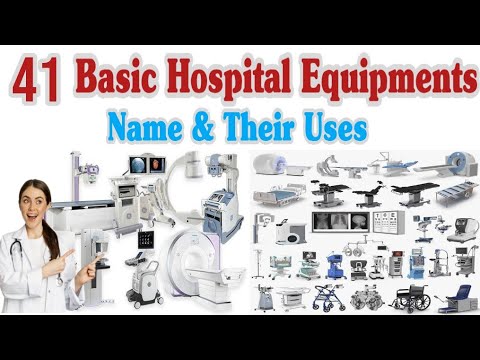The Most Important Medical Assistant Equipment
Contents
As a medical assistant you will be working with a variety of different equipment. While some of it will be fairly standard, other pieces may be more specialized. Here is a list of the most important medical assistant equipment you will need to be familiar with.
Checkout this video:
Exam room equipment
As a medical assistant you will likely work in an exam room with a physician. There are several pieces of equipment that are found in most exam rooms. These items are essential to the physician in order to provide quality patient care.
-A medical assistant stool or chair so that the medical assistant can sit close to the patient and have easy access to supplies.
-An examination table with stirrups for pelvic exams or Pap smears.
-A blood pressure cuff and stethoscope for taking vital signs.
-An otoscope for examining ear, nose, and throat patients.
-A reflex hammer for testing reflexes.
Laboratory equipment
In a medical assistant career, you’ll likely have the opportunity to work with a variety of laboratory equipment. From specimen collectors to microscopes, this type of equipment is essential in a clinical setting. Here are some of the most important pieces of laboratory equipment you’ll need to know how to use as a medical assistant:
-Centrifuge: Used to separate blood or other fluids into their component parts.
-Hematocrit Reader: A device used to measure the percentage of red blood cells in a sample.
-Microscope: Used to magnify small samples for examination.
-pH Meter: Used to measure the acidity or alkalinity of a substance.
-Refractometer: Used to measure the amount of light that is bent (refracted) by a liquid.
-Stethoscope: Used to listen to heart, lung, and other body sounds.
-Thermometer: Used to take body temperature readings.
Diagnostic equipment
There is a variety of diagnostic equipment that Medical assistants use to perfom their job duties. This type of equipment includes, but is not limited to, blood pressure cuffs, stethoscopes, otoscopes, and thermometers.
Blood pressure cuffs are devices that measure blood pressure. They are composed of an inflatable cuff, a gauge, and a inflation bulb. The cuff is placed around the upper arm and inflated with air. The gauge measures the pressure of the air in the cuff and the inflation bulb is used to inflate the cuff.
Stethoscopes are used to listen to heart and lung sounds. They have a diaphragm that vibrates when it comes in contact with sound waves. The diaphragm transmits these sound waves to the earpieces of the stethoscope where they are amplified so they can be heard clearly.
Otoscopes are used to look in the ear canal for signs of infection or disease. They have a light at the end of them that illuminates the ear canal so that the medical assistant can see any abnormalities.
Thermometers are used to measure body temperature. There are many different types of thermometers including oral, rectal, ear, and forehead thermometers.
Therapeutic equipment
In order to provide the best possible care to patients, Medical Assistants must be familiar with a variety of therapeutic equipment. This equipment includes:
-Aneroid sphygmomanometers: Used to measure blood pressure
-Stethoscopes: Used to listen to heart, lung, and bowel sounds
-Otoscopes: Used to examine the ear
-Thermometers: Used to take oral, rectal, and axillary temperatures
-Tongue depressors: Used to depress the tongue during an oral examination
-Penlight: Used to check pupils for size, equality, and reactivity to light
Pharmacy equipment
Working in a pharmacy, you will be responsible for many different tasks. You will need to be able to measure and mix medications, as well as keep track of inventory. To do this, you will need to be familiar with the various types of pharmacy equipment.
Some of the most important pieces of pharmacy equipment include:
-Measuring devices: these are used to measure the correct amount of medication for each patient. Measuring devices include graduated cylinders, measuring spoons, and measuring cups.
-Mixing devices: these are used to mix different medications together. Mixing devices include mortars and pestles, spatulas, and stirrers.
-Inventory control systems: these are used to keep track of the medications in the pharmacy. Inventory control systems can be manual or electronic.
Pharmacy equipment is essential for providing quality patient care. Make sure you are familiar with all of the different types of equipment before you begin working in a pharmacy.
Office equipment
Office equipment is essential for any medical assistant. Here are a few pieces of equipment that you’ll need to have in your office:
-A computer with internet access and word processing software.
-A printer.
-A fax machine.
-A telephone.
-An appointment book or scheduling software.
– Medical reference books.
– A file cabinet to store patient records.
Sterilization equipment
The medical assistant profession often involves contact with patients and their bodily fluids. This means that sterilization equipment is essential in order to protect both patients and medical assistants from potentially harmful bacteria and viruses.gloves, face masks, protective eyewear, and gowns are all items that should be worn when working with any type of bodily fluid. In addition, sterilization equipment such as autoclaves and sterilizing solutions are used to clean instruments and surfaces that come into contact with bodily fluids.
Imaging equipment
If you are thinking about becoming a medical assistant, you need to know about the different types of equipment you will be using. One type of equipment you will use often is imaging equipment. This type of equipment is used to take pictures of the inside of the body. There are many different types of imaging equipment, and each has its own purpose. Here is a list of the most common types of imaging equipment used by medical assistants:
-X-ray machine: An X-ray machine is used to take pictures of bones and organs. X-rays are taken with a special film that is placed over the area being imaged.
-CT scanner: A CT scanner is used to take pictures of the inside of the body, including the brain and organs. CT scanners use x-rays and computer technology to create images.
-MRI machine: An MRI machine is used to take pictures of the inside of the body, including the brain and organs. MRI machines use magnetic fields and radio waves to create images.
-Ultrasound machine: An ultrasound machine is used to take pictures of the inside of the body, including the fetus during pregnancy. Ultrasound machines use sound waves to create images.
Monitoring equipment
Monitoring equipment is one of the most important pieces of equipment for medical assistants. This type of equipment helps track patients’ vital signs, such as their blood pressure, heart rate, and respiration.
Miscellaneous equipment
There are a few pieces of miscellaneous equipment that medical assistants use on a regular basis. These items include syringes, gloves, and bandages. While they may not be used as frequently as other pieces of equipment, they are still an important part of a medical assistant’s job.
Syringes are used to inject medication into a patient’s body. They come in various sizes, depending on the amount of medication that needs to be injected. Gloves are worn by medical assistants to protect their hands from germs and bodily fluids. Bandages are used to cover wounds and protect them from infection.







